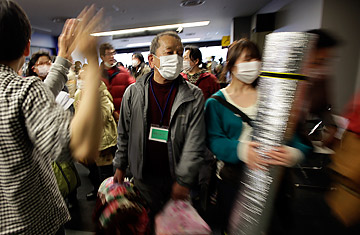
Local officials guide evacuees from Futaba, in Fukushima prefecture, in the emergency shelter at Saitama Super Arena, near Tokyo
By 9:30 a.m. local time on March 22, the emergency shelter at Saitama Super Arena, just north of Tokyo, had reached its maximum capacity of 500 volunteers. The other 1,500 do-gooders wanting to help the displaced people of Futaba, the town closest to ground zero of the earthquake- and tsunami-damaged Fukushima Daiichi nuclear plant, were turned away by volunteers holding hand-printed cardboard signs that said "We are sorry, but we cannot take any more volunteers. Please try again tomorrow."
Inside the arena, which normally hosts rock concerts, some 5,000 earthquake, tsunami and nuclear-plant refugees, including those from Futaba, were trying to carve out a normal routine in their makeshift homes, composed of squares of blankets and mats. There to help them were the volunteers, who handed out free bananas, blankets, diapers, toys and other necessities for people who escaped with little more than the clothes on their backs. Some volunteers held signs presenting complimentary day-care services, while others offered free shampoos, blow-dries and shaves at local beauty parlors. "It's the least I can do," said Hideyuki Tanaka, a stylist with dyed blond hair who held a sign offering free salon services. "I don't have any other skills except for this, so I thought I could make this small contribution." By noon, some 60 evacuees had taken advantage of free services at his Maggie Friends beauty salon.
The Saitama emergency shelter is a model of organization and goodwill, with masking-tape arrows pointing the way to the bath, food and clothing lines. Bowing, smiling volunteers shepherd dazed-looking evacuees from one line to another. But in northeastern Japan, where an estimated 21,000 are dead or missing and another 350,000 are homeless as of March 22, the country's labyrinthine bureaucracy has seriously hampered efforts to deliver aid. Some shelters still have no heat, while others are rationing rice balls. In a country that prides itself on efficiency, the fact that 11 days after the earthquake, displaced people are still hungry and, even if they have cars, cannot get food because of a shortage of fuel is a shocking turn of events. The aid bottlenecks are all the more surprising given that most Japanese anticipated that their government would respond quickly. "There are very high expectations of the government here, and civil society is struggling to find its place," says Randy Martin, director of global emergency operations for Mercy Corps, a U.S.-based NGO. "The most important thing is to get the supply chain going again."
In other natural disasters that I've covered, steady streams of local and international aid have usually converged upon the stricken area within four days of the event. This has happened even in developing-world countries with far less infrastructure than Japan has. But in Tohoku, as Japan's northeast is called, aid has trickled in agonizingly slowly, despite the mobilization of 100,000 Japanese soldiers for the relief effort. It took more than a week after the earthquake, for example, for the region's highways, which are reserved for emergency vehicles, to be filled with the kind of aid convoys that typically race to disaster scenes.
One major bottleneck has been Japan's fondness for red tape. "In special times, you have to do things in a special way," says Kensuke Kobayashi, an IBM employee in Tokyo who has tried to organize relief efforts to Tohoku from the Japanese capital. "But in Japan, there is a legal wall that stops everything." Japanese shipping company NYK offered to provide a container ship for helicopters to land on when ferrying in relief supplies to coastal areas. But the government rejected the offer because the NYK shipmates lacked the proper licenses to help with such work. After some wrangling, volunteer foreign doctors were told that because they didn't have Japanese medical licenses, they could conduct only the "minimum necessary medical procedures" in the disaster zone.
Some medicine donations from overseas haven't reached the many elderly suffering in the earthquake's aftermath because Japanese regulatory agencies have not yet given the drugs approval. Local logistics companies have complained — off the record, for fear of angering the bureaucrats whom they depend on for future licensing — of days-long waits for permission from the central government to deliver donated goods. Only when their trucks get the magic pass can they start moving toward Tohoku. Until then, the boxes of relief goods, some of which were donated just hours after the earthquake and tsunami hit, sit in Tokyo warehouses.
